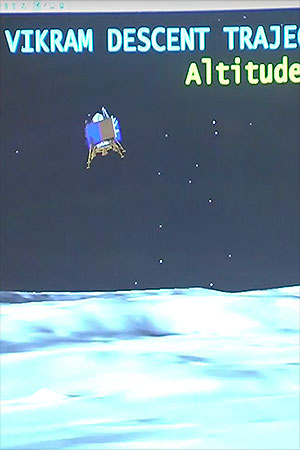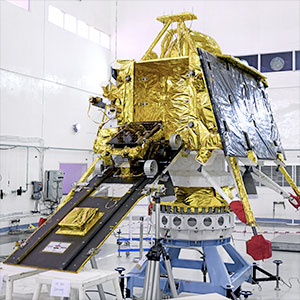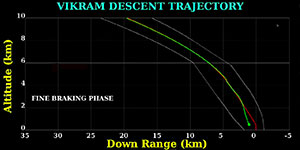September 6, 2019 — India's first attempt at landing a spacecraft on the moon ended more than a mile above the lunar surface when communications with the probe were lost.
The Indian Space Research Organization (ISRO) had been proceeding toward a touchdown with its Vikram lander, part of the Chandrayaan-2 mission, on Friday (Sept. 6). The feat would have established India as only the fourth country to land a spacecraft on the moon, joining Russia, the United States and China.
But after a 46-day journey and with only minutes to go until the expected landing at about 4:30 p.m. EDT (2030 GMT or 2:00 a.m. Sept. 7 India Standard Time), the robotic probe went silent.
"Vikram Lander descent was as planned and normal performance was observed up to an altitude of 2.1 kilometers [1.3 miles]. Subsequently communication from lander to the ground stations was lost," K. Sivan, ISRO chairman, read out in the mission control center. "Data is being analyzed."
"There will always be hurdles in life," Indian Prime Minister Narendra Modi later said, consoling the flight team. "You've done a great job and the country is proud of you. I am with you always."
ISRO did not immediately declare the landing a failure, though a telemetry display at the front of the control room appeared to show the spacecraft had veered off its planned course before data was lost.
Launched by a GSLV Mk-III rocket from India's Satish Dhawan Space Center on July 22, the Chandrayaan-2 mission — comprised of an orbiter, lander and rover — spent several weeks raising in orbit around Earth until entering the influence of the moon on Aug. 20. Thirteen days later, after maneuvering into the desired orbit, the lander separated from the orbiter on Sept. 2.
The Vikram lander, named for the "father of the Indian space program," the late physicist Vikram Sarabhai, was programmed to follow a 15-minute autonomous descent to the lunar surface. The 8-foot by 6.5-foot (2.5 by 2 meter) spacecraft was targeting a landing on a high plain between the Manzinus C and Simpelius N craters in the moon's south polar region at a latitude of about 70 degrees South.
Equipped with four corner-mounted thrusters and a central engine, the lander was to use a laser range finder and hazard avoidance camera to inform its on board guidance computer to control its rate of descent and refine its landing site target. Sensors on the probe's four legs were to signal the touchdown.
Once safely on the surface, the Vikram lander was designed to operate for half a lunar day, or two weeks on Earth. One of its first actions would have to been to deploy a six-wheeled rover called "Pragyan" for the Sanskrit word for "wisdom." The rover was capable of driving up to a third of a mile (0.5 kilometers), moving at 0.4 inches per second (1 centimeter per second).
The Pragyan rover was to send back data about the composition of the lunar soil (regolith) and the presence of water ice. The lander was also equipped with science payloads to study the moon's thin exosphere and the seismic activity on the surface.
Both the lander and rover were outfitted with cameras. The lander also carried a NASA-provided laser retroreflector, similar in purpose but smaller in size than the retroreflector left on the moon by the Apollo 11 mission 50 years ago.
Had they landed successfully, the solar-powered lander and rover were expected to eventually succumb to the setting of the sun and the extreme low temperatures that would follow.
The Chandrayaan-2 orbiter is expected to continue to circle the moon for at least the next year, gathering imagery and data about the distribution of water ice. The Chandrayaan-2 mission is a follow-up to India's Chandrayaan-1 orbiter, which in 2009 discovered the presence of water ice in the permanently-shadowed craters of the moon's poles.
India is the second nation to fail at its first attempt at a moon landing this year. In April, Israel's Beresheet lander was lost in the last few minutes of its descent due to an errant command prematurely cutting off its engine.
Chandrayaan-2 is the 123rd attempted moon mission, including flybys, orbiters, impactors and landers. The Vikram lander would have been the 21st spacecraft to touch down on the lunar surface had it been successful. |
|

A display at the Chandrayaan-2 control center in Bengaluru, India showed the Vikram lander's final approach to the lunar surface until communications were lost. (ISRO)

India's Chandrayaan-2 Vikram lander and Pragyan rover seen prior to their launch to the moon on July 22, 2019. (ISRO)

A display at the Chandrayaan-2 control center in Bengaluru, India showing the Vikram lander's descent trajectory to the lunar surface until communications were lost. (ISRO) |
